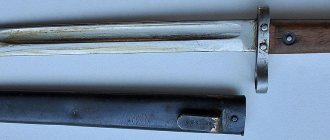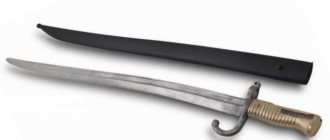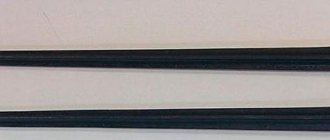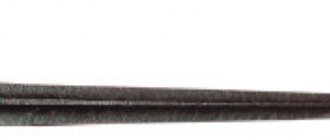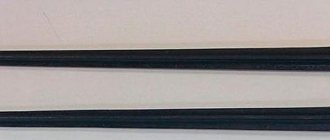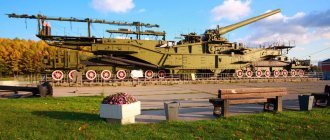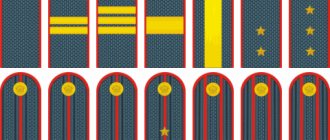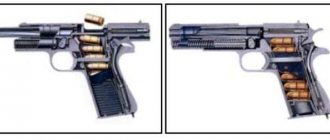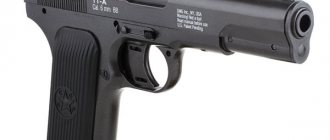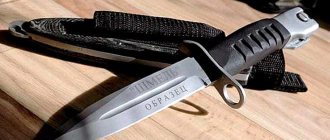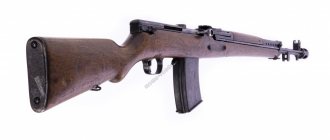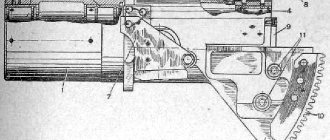History of the development of the Mauser bayonet knife
Throughout the history of production of a wide variety of models and variants, it is the Mauser bayonet knife that is considered the progenitor of all bayonet knives. This sample is the most widespread ever produced in history. For a long time it was an attribute of a real warrior and even in some countries it is still in service and, one might say, not only as a ceremonial bayonet knife . In total, about 15 million knives were produced, and established production was noted in several dozen countries.
The German S84/98 bayonet was initially designed for use in cavalry, field artillery, and technical troops; its production began in 1915. A little later, assault units also received it. While until 1915, such bayonets, the blade length of which was 22.5 mm, were produced only for special supply units, cyclists and others. This bayonet was successfully used in the First and Second World Wars, and was supplied to almost every corner of the planet under reparations or on the basis of commercial contracts.
Almost fifty years before this Mauser knife , specialists in various countries tried to develop and adopt similar multi-purpose weapons. For example, in the United States, a bayonet knife was developed for the Marine Corps in the second half of the nineteenth century, but due to a number of specific reasons its need was never fully realized. But the situation changed significantly at the beginning of the twentieth century, when the tactics of close combat changed and, as practice showed, there was an urgent need for assault units to have short bladed weapons.
Souvenir bayonet knives of the “NS-AK” series
Bayonet knives for Kalashnikov assault rifles are an indispensable attribute of any collection of modern edged weapons. The large number of blades produced contributed to the widespread distribution of such samples among collectors. However, beginning collectors often have to deal with legal problems. Bayonet knives are edged weapons, which is why their acquisition and storage is associated with some difficulties. A few years ago, the manufacturing company met the needs of collectors and made the process of acquiring new “artifacts” easier. Army warehouses have accumulated a large number of bayonets of various types, which are unlikely to ever return to service, but are still of interest to civilians, primarily to collectors. Sometimes army blades in one way or another, and not always legally, end up in private collections, but there were no legal ways to obtain such samples until a certain time. The solution to this problem was the release of two types of souvenir bayonet knives. A few years ago, now the parent enterprise of the Kalashnikov concern, offered everyone new versions of serial bayonets that are no longer melee weapons.
According to existing legislation, a blade is classified as a bladed weapon if it has a number of characteristics, including a certain length and strength of the blade, the presence of hand protection elements, etc. Thus, if several parameters do not meet a certain standard, the bayonet can be recognized as a household item. This is exactly the path the authors of the souvenir bayonet project took in preparation for their release.
Souvenir version of the 6X4 bayonet - “NS-AK Sb-01”. Photo Bayonet.lv
For some time, Izhmash produced two versions of souvenir bayonet knives, based on serial cold weapons. For its production, bayonets were removed from storage, received new markings, and were also subjected to a procedure that reduced the strength of the blade and made it possible to transfer them to the household category. Thus, collectors and other interested people had the opportunity to get a real bayonet for a Kalashnikov assault rifle, including one produced several decades ago, but to do this without a lot of additional procedures associated with special permits, etc.
Souvenir bayonets were produced under the general name “NS-AK”, which stood for “Souvenir knife - Kalashnikov assault rifle”. During the alteration, characteristic markings were applied to the blades of the bayonets, which allows you to distinguish a souvenir sample from a combat one at first glance. On the side surface of the blades there was an engraving in the form of the plant’s emblem (stylized inscription “Izhmash” with an arrow in a triangle) and a large inscription “NS-AK”. Such markings were oriented “in a combat style”: the inscriptions were read correctly when the bayonet was turned with the mounts upward, as when installed on a weapon. The souvenir bayonets of the two models had the same engraving with the plant emblem and name. No other indications of the type of souvenir were provided.
After completing all the necessary procedures, “NS-AK” underwent technical control and received the appropriate stamp. The OTK mark was affixed in ink on the heel of the blade. No new markings were provided for the scabbard; existing marks were retained on them. After alteration, the bayonet-knife retained various brands and marks applied during production in the past. Thus, a considerable number of souvenir products simultaneously bore the marks of two enterprises, for example, the Tula Arms Plant, which manufactured the blade, and Izhmash, which remade it for free sale.
The main way to change the legal status of the blade was to change its strength characteristics. This made it possible to reclassify bladed weapons as household items, and also not to subject them to drastic modifications, including those that distorted the appearance and thereby sharply reduce the collection value. All such alterations consisted of making a cut that weakened the blade. A cut was made on one of the surfaces of the heel of the blade to a depth of about two-thirds of the thickness of the metal. The resulting groove seriously reduced the strength of the blade and thereby allowed it to meet the requirements for “household use.”
Two types of bayonet knives underwent modifications to enter the civilian market. Samples of type 6X4 were removed from storage. In addition, model 6X5 bayonets were redesigned (or produced from scratch on the basis of ready-made components, but with appropriate nuances). Both versions of souvenir bayonets were called “NS-AK”. In addition, a souvenir based on 6X4 is sometimes designated by the additional index “Sb-01”. The modified 6X5 is most often referred to as “NS-AK 6X5”. In relation to 6X4, a similar designation is also often used.
Souvenir bayonet knives were made from real serial edged weapons, which gave them several characteristic features. With the exception of markings and a weakening cut, from a design point of view, they were a complete copy of combat models. The shape and dimensions of the blade, the design of the handle, as well as the means of fastening on the machine gun and the scabbard were preserved.
Engraving on the blade indicating the name of the product. Photo Bayonet.lv
The NS-AK Sb-01 product, being a slightly modified version of the 6X4 bayonet, had a recognizable blade shape with a beveled butt and double-sided sharpening of the combat end. One edge of the blade retained its sharpening, while the second retained a serrated notch. There was also a hole in place for attaching it to the scabbard when using the bayonet as a wire cutter. The only change to the blade was a cut, which reduced its strength and did not allow its use as a bladed weapon.
On the handle of the souvenir knife there was a cross with a ring for installation on the barrel of a weapon and a hook for attaching a strap. The plastic handle linings with corrugation remained in their place for comfortable holding. The head of the handle was still equipped with a spring-loaded latch, controlled by a button on the right side (when positioned “combat-style”). On the opposite side of the head there was a loop for a strap.
Modifications to the blade did not lead to any noticeable changes in the size and weight of the structure. The total length corresponded to the basic 6X4 and was 270 mm with a 150 mm blade with a width of 30 mm. The weight of the bayonet-knife in the souvenir configuration was slightly less than 250 g. The difference in weight was associated only with the removal of a small amount of metal from the heel of the blade.
Despite the weakening and marking of the blade, the souvenir 6X4 retained the existing sheath, made of an oblong metal part and a plastic lining. A block with fastenings and a cutting edge for using a bayonet with a scabbard as wire cutters was also preserved. On one side of the plastic cover there were still fastenings for the belt system for suspension.
The second version of the “Souvenir Knife – Kalashnikov assault rifle” was made on the basis of the 6X5 bayonet knife. This bayonet had a different blade shape with a symmetrical double-sharpened combat end. The cutting edges of the blade were provided with a main sharpening and a serrated file. In addition, there was a hole for fastening to the scabbard. The handle consisted of a main plastic lining and a cross and a latch inserted into it. For mounting on a weapon, it was proposed to use a ring on the crosspiece and a spring-loaded latch in the head of the handle. The handle plate had an ergonomic shape with corrugation and several transverse ribs.
Souvenir item based on a 6X5 bayonet. Photo: Forum.guns.ru
The total length of the souvenir bayonet remained at 290 mm, the blade had a length of 160 mm and a width of 29 mm. The weight of the bayonet was at the level of 220-230 g.
The 6X5 bayonet scabbard was a slightly modified unit from the previous 6X4. The main metal part for storing the blade was covered with a plastic cover and equipped with a block for use as wire cutters. For hanging on a belt and fixing the bayonet there was a loop and a strap with a clasp. The most noticeable difference between the 6X5 sheath and the older product was the color. In the case of 6X4 bayonets, the scabbard was made of brown plastic, while on 6X5 bayonets black or dark polyamide was used.
All modifications to serial bayonet knives consisted only of weakening the blade structure and did not affect other parts. Thus, the products of the NS-AK series were full-fledged weight and size models of edged weapons. The ability to cut various objects and materials was also retained. However, the manufacturer warned about the need to care for the blade and the undesirability of using the souvenir as a cutting tool. Preservation of the mounts made it possible to install souvenir bayonets on machine guns or models of small arms of compatible models.
Souvenir bayonet knives were produced for several years and were sold without the special permits required when purchasing edged weapons. According to some reports, the production of such products ceased several years ago, which is why stores are currently completing the sale of the remaining batches purchased earlier. There is no information about the possible continuation of the production of souvenir products, which are of great interest to a wide range of collectors and the interested public.
Based on materials from the sites: https://bayonet.lv/ https://forum.guns.ru/ https://rusknife.com/
Main characteristics of the Mauser bayonet knife
The German Mauser bayonet knife has a blade and shank, which are a steel plate that expands significantly at the end of the handle, thereby forming a heavy pommel. This is what provides it with excellent mechanical strength and good balance. It is worth noting that the pommel is made of a monolith with a blade and a shank. The base of the blade is secured with a guard, the sides of the shank have special screws on which wooden cheeks are mounted. The pommel also has a hole, which is necessary for attaching to the tide on the rifle, and a button for fixing. The blade involves one-and-a-half sharpening and has two stiffening ribs.
In order to appreciate all the advantages, high performance characteristics and quality of this bayonet, you just need to take it in your hand. German versions of this weapon do not have rings for attaching to the barrel; instead, a hole is used in the shank, into which a cleaning rod is also inserted. This bayonet knife has a steel plate on the back of the handle; its cheeks are most often made of wood, but sometimes you can also find an option with bakelite cheeks. The difference between the Mauser knife is that it is quite heavy and its blade has never been sharpened. This is due to the fact that they were delivered from the manufacturer’s factory unsharpened, and all parts are marked, namely, military acceptance marks are visible, but the code indicates that the weapon was produced by an unknown company in 1935. The marking of German bayonet knives is quite important, as it helps to determine exactly the type of weapon and the year of its manufacture.
Today, it is unlikely that anyone will decide to carry this 98k knife bayonet and use it for self-defense, since, first of all, it will be uncomfortable due to its considerable dimensions. In addition, the Mauser bayonet knife is of historical value. Today this instrument is an interior item and part of a collection of edged weapons. It is also an attribute of military reconstruction. It is worth noting that in our time there are even separate trends in collecting that are dedicated specifically to this bayonet knife.
Mauser knife bayonet mount
The Wehrmacht's main weapon in all troops was the Mauser 98k carbine. This carbine was equipped with a bayonet and a blade-type knife and was attached to the carbine using a special tip located on the stock. As a rule, warriors wore bayonet knives on the left thigh, but if there was a shoulder blade, then the knives were attached above the shoulder blade. The bayonet knife was inserted into a special black metal sheath, which had a special hook for good fixation in the case. Despite the fact that the sheath was originally designed only for the sheath of the S84/98 bayonet knife, it was used for all variants of German and even captured ceremonial sheaths. All of them could be inserted into this case.
Almost all existing models of cases had a similar device, namely:
- consisted of a leather base forming a special loop for a waist belt;
- had a pocket in which there was a hole intended for a strap and a sheath hook;
- The pocket contributed to the stable fixation of the handle of the knife bayonet.
The Wehrmacht produced several types of such sheath covers. As for the infantry cover, it was made of black leather, had a tapering base and did not have a fixing strap. The cavalry case was only slightly different from the infantry case, this difference was that it had a fixing strap, was also made of black leather and had a tapered base. Beginning in 1939, sheaths began to be issued to absolutely all military personnel, since infantrymen, while in the field, quite often lost their bayonet knives. Already in 1942, black leather cases with a narrow short base and a fastening leather strap began to be used in small quantities. In the production of cases, some changes could be observed and on some cases the bases became made of fabric, but the fixing strap and pocket for the sheath of the Mauser bayonet knife remained exclusively leather.
One should not ignore the fact that in the Third Reich, non-commissioned officers and ordinary soldiers of the German army had the opportunity to buy ceremonial versions of bayonet knives with their own money. They were allowed to wear them at the oath, parade and other various ceremonies. The ceremonial bayonet knife was made from high-quality nickel-plated steel; the knife had a handle stylized as an eagle's head, had an elongated hilt and black bakelite cheeks with a fine notch. In fact, there were only two versions of the ceremonial bayonet knife - a knife with a long blade, 24 cm long for ordinary military personnel, and a short blade, 20 cm long for non-commissioned officers. As for the covers intended for ceremonial bayonet knives, they were made of patent leather and had a narrower base in the center. There were also no metal rivets on them.
The value of the Mauser bayonet knife today
It is worth noting that the Mauser bayonet knife is of unique historical value; today this type of bladed weapon is one of the most popular and desirable for every collector. In particular, samples made since 1898 are especially popular. In most countries, this, one might say, antique is used in service to this day, and this is not surprising, because with this bayonet, German troops fought two world wars. Many collectors of our time are engaged in collecting bayonets of the 84/98 model, because these models were manufactured in many countries by a huge number of companies, and their production lasted several decades.
The main purpose of collecting is the marking and numbering of weapons, which were assigned to each specimen during production. After the end of the world wars fought by Germany, in particular after its defeat, it was forced to supply bayonets to various countries around the world as reparations. It is also important that antique bayonets for Mauser rifles were supplied to other countries on a commercial basis even in pre-war times. It is for these reasons that the Mauser bayonet sold in millions of copies literally all over the world.
Today, collectors have a unique opportunity to purchase a Mauser ceremonial bayonet knife. You can look for a similar collector and lover of ancient weapons, who may agree to part with his bladed weapons and sell them for a certain amount of money. You can open the World Wide Web and communicate with other collectors on various forums, maybe they will suggest an option for purchasing this model of bayonet knife. In addition, today there are many online stores offering bayonet knives for purchase. It all depends on your desire and desire to purchase this type of weapon.
" Bayonet Knife Mauser" read 3460 times
Bayonet mod. 1884/98 for Mauser rifles
Although our forum is about knives, in the Army I will take the liberty of writing a micro-review about perhaps the most popular and desirable bayonet for novice collectors - the German bayonet-knife for Mauser rifles and carbines, starting with the rifle mod. 1898 onwards. The Germans fought the First and Second World Wars with this bayonet, and in some countries it is still in service today. There is a special type of collecting - collecting bayonets mod. 84/98, since they were made by a bunch of companies for decades, they used a variety of markings and numbering, which is actually the purpose of collecting. After the world wars, Germany, which traditionally lost them, supplied reparations with bayonets to a variety of countries, plus pre-war commercial supplies, so this bayonet was sold in millions of copies around the world.
In the second half of the 19th century, the most technologically advanced countries - the USA, Germany and Austria - came to the still poorly realized conclusion about the need to create shortened bayonets for some units, for example, the earliest Dahlgren bayonet - US Navy Mod.1861 for the Marine Corps. However, it turned out to be too early for the consciousness and methods of warfare of that period and did not receive development.
In Germany, for arming auxiliary units that were hindered by a long bayonet, for example, for cyclists, etc. in 1885-86. adopted the bayonet mod. 71/84, which was used with rifles mod. 71/84, hence the name. The bayonet had an incredibly short blade with a length of about 225 mm, and according to traditional opinion, it is the first real bayonet-knife in history; for example, I will say that the bayonet mod. 71, the same rifle had a 470 mm blade.
This bayonet did not last long, mainly in Bavaria; Bavarian units fought with it in the First World War. In the remaining German kingdoms in the period 1908-9. by using part of the elements of this bayonet, and part of a long bayonet mod. 98 adopted the bayonet mod. 84/98, the so-called old type, in contrast to the later - new type. This bayonet already displays almost all the characteristic distinctive features of the future bayonet, and the main one is the absence of a ring for fixing the bayonet on the barrel. Instead, there was a hole along the handle of the bayonet into which a ramrod entered. Some of the bayonets were remade from 71/84 bayonets; their fuller goes almost to the tip. Bayonet blade length 84/98. respectively 225 mm. The purpose of the bayonet did not change - auxiliary units: cyclists, motorists, reservists, etc. The line infantry was still armed with long bayonets.
Photos from here: https://forum.bajonet...fb2e898ca462e9f
